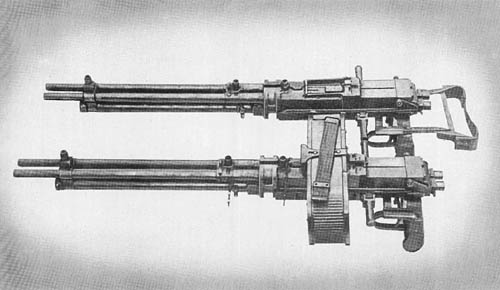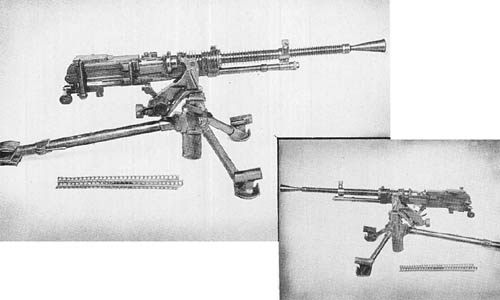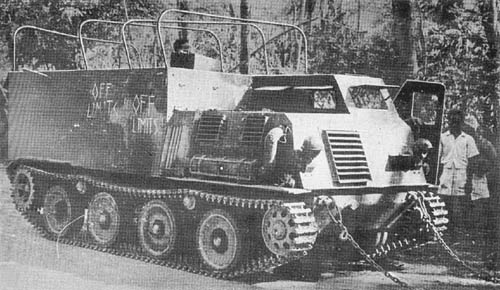
These two weapons which are very similar offer the advantage of two guns being mounted in the space occupied by one gun of normal size, thus saving weight in the gun and mount, and space in the plane. A small ammunition supply making frequent magazine changes necessary is a disadvantage partially for the advantages of the double barrel principle.
The operating mechanism for both barrels is housed in a single receiver. This is a single forging, milled to house the two separate actions. The magazine opening is cut out of the top of the receiver, the ejection slot out of the bottom. Each action has its own back plate. The gas piston group resembles the Bren light machine gun in design. The bolt is a steel forging well machined. The gas cylinder tube is constructed of seamless steel tubing and is threaded to the receiver at the rear. The trigger assembly is made up of two separate sear assemblies riveted to the pistol grip framework. Two pistol grips are located about 6 inches apart; the sears are connected to a horizontal trigger bar mounting a trigger on either end. Both guns may be fired by depressing either trigger. The magazine is the saddle-drum type. Each side holds 50 rounds and feeds one gun. Each side has its own spring so that, in the event of a jam affecting one barrel, the other gun may continue to fire.
The Model 1 (1941) gun appears to be basically the same weapon as the earlier model, Model 100 (1940) which is shown at the bottom of the illustration. The Type 1 gun shown at the top of the picture has a head or shoulder rest attached to the gun. This rest is made of wood and canvas and is attached to the gun with steel frames. The specifications were secured from the earlier weapon.
SPECIFICATIONS
| Caliber | 7.92 mm | |
| Weight of gun | 36 lbs. | |
| Length (overall) | 37.5 ins. | |
| Length of receiver | 16.25 ins. | |
| Length of barrel | 24.5 ins. | |
| Length of rifling | 22.37 ins. | |
| Diameter of bore— | ||
| across lands | 0.310 in. | |
| across grooves | 0.313 in. | |
| Number of lands | 4 | |
| Width of lands | 0.0781 in. | |
| Width of grooves | 0.1718 in. | |
| Depth of grooves | 0.003 in. | |
| Twist of rifling | Uniform R.H. | |
| Pitch of rifling | 7° (approx.) | |
| Type of operation | Gas | |
| Type of fire | Automatic only | |
| Type of feed | Magazine, saddle-drum type | |
| Capacity of magazine | 100 rounds | |
| Weight of magazine empty | 7 3/4 lbs. | |
| Weight of magazine filled | 13 3/4 lbs. | |
| Ammunition | A.P.—Incendiary | |
| Rate of fire (estimated) | 400-600 r.p.m. | |
| Range | 250 to 350 meters |
Japanese: p. 216.1 (March 1, 1945)

